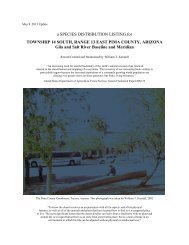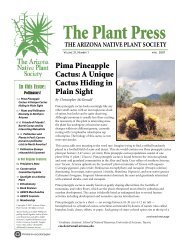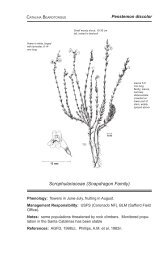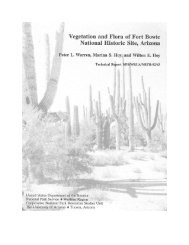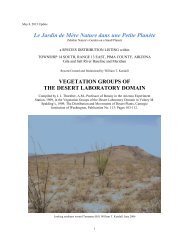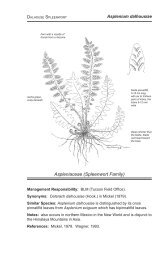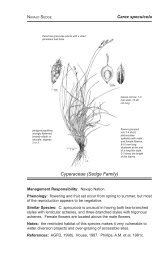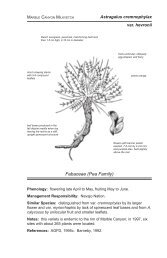Astragalus nutriosensis
Astragalus nutriosensis
Astragalus nutriosensis
You also want an ePaper? Increase the reach of your titles
YUMPU automatically turns print PDFs into web optimized ePapers that Google loves.
NUTRIOSO MILKVETCH<br />
<strong>Astragalus</strong> <strong>nutriosensis</strong><br />
Dwarf, acaulescent, perennial herb from a<br />
short, knotty caudex on a simple taproot;<br />
3.5-7.5 cm tall, 7.0-10.0 cm wide<br />
leaves 3.0-11.0 cm long,<br />
petiole half that length<br />
inflorescence<br />
does not<br />
ascend above<br />
the leaves,<br />
and bears 2-5<br />
flowers that<br />
point upward<br />
pods 0.8-1.0 cm long, broad, a little<br />
incurved, terete in cross-section,<br />
bilocular, and papery<br />
petals white with pink-purple veins<br />
or tips; wings 1.9-2.2. cm long<br />
Fabaceae (Pea Family)<br />
Phenology: flowering late April to May.<br />
Management Responsibility: USFS (Apache-Sitgreaves NF), private.<br />
Similar Species: distinguished from A. mollisimus var. matthewsii by a<br />
much smaller pod, an almost sessile inflorescence with few flowers, and<br />
generally paler flowers with barely recurved banners.<br />
References: AGFD, 1997g. Baker and Wright, 1995. Sanderson, 1988.
<strong>Astragalus</strong><br />
<strong>nutriosensis</strong><br />
USFS<br />
Habitat: on basaltic mesa<br />
tops in gravelly loam soils in<br />
open grassland, sometimes<br />
among pinyon and juniper,<br />
7,040-7,800 ft (2145-2375<br />
m) elevation.<br />
Marc Baker<br />
Marc Baker<br />
Range: eastern Arizona, between<br />
Springerville and Nutrioso; also found<br />
in New Mexico.



